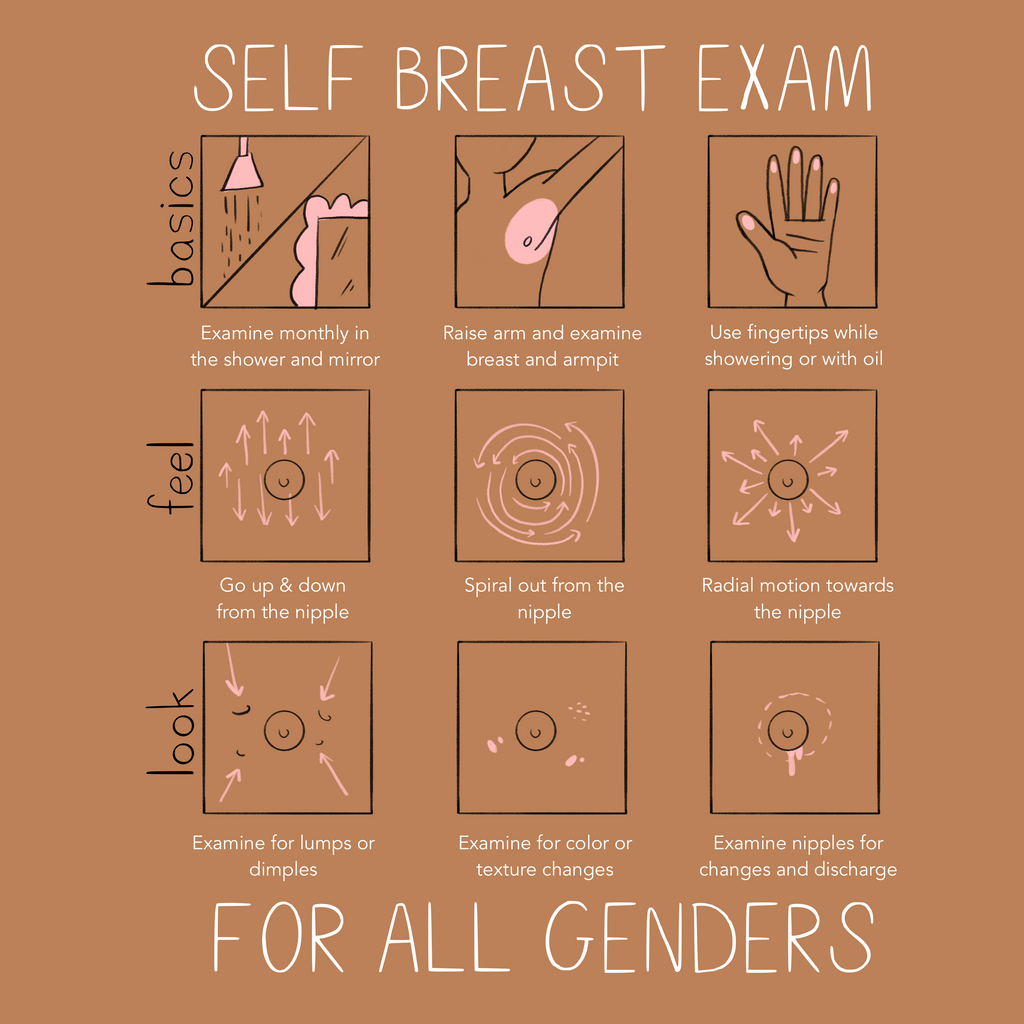written by Dr Mare (she/her) @bookedwithdrmare
Self breast exams (SBEs) have been a little controversial in the last several years. Some studies have concluded that SBEs do not have a meaningful impact on breast cancer survival rates, and may even cause harm by prompting unnecessary biopsies, which is the removal and examination of suspicious tissue. As a result of this uncertainty, the American Cancer Society no longer recommends SBEs for those who are at average risk for breast cancer.
However, many people still want to learn how to perform SBEs. When done correctly (and sparingly), they can still be an important step in screening for breast cancer and other breast abnormalities. Just remember, no single test is going to catch every breast cancer early. But when done in conjunction with other screening methods like clinical breast exams (done by your provider), mammograms, and ultrasounds, SBEs can certainly increase the chances of early detection and subsequent treatment.
How to Give Yourself A Breast Exam
The great thing about SBEs is that they’re convenient and easy to do on a regular basis with no cost to you. But how do you do them? Like everything in life, there’s no single right answer. Even as a clinician, we are taught multiple ways to perform an SBE. The important thing is to learn the correct and thorough method that you can easily replicate each time you perform your exam.
The more you examine your breasts, the more you will familiarize yourself with them and be able to tell if something has changed. The breasts can feel different from each other and within different regions of the same breast. The upper, outer area near the armpit tends to be the most prominent in terms of lumps and bumps. The lower half can feel much finer like sand. The area under the nipple might feel pebbly. And other areas may also feel different. This is all normal. What’s important is to track new changes from your normal.
Some people find taking notes to be helpful, especially when just starting out. Drawing a visual or writing down your findings can help you remember what is “normal” for your breasts. For example, it’s totally normal for breast tenderness and lumps to appear and disappear at certain times of the month as your hormones change with the menstrual cycle (if you are menstruating). Being mindful of this will help you better understand if there’s cause for concern or not the next time it happens.

Step 1: The Basics
Let’s start by making sure we have the right setup, shall we?
Timing
At most, you should perform an SBE on a monthly basis. Examine yourself several days after your period ends, when your breasts are least likely to be swollen and tender. If you don’t have periods, choose a day that's easy to remember, like the first or last day of the month.
Location
The easiest place to do an SBE is in the shower and/or in front of a mirror.
Position
Make sure you are upright in a sitting or standing position. Raise your arm on the side you’re examining so you can feel around your armpits as well.
Tools
This one’s easy. All you need is your fingertips! And maybe some body oil so your fingers glide easily on your skin.
A body oil will help your fingers glide smoothly across your skin. Shop Tonic oil.
Step 2: Look
Start by looking at your breasts in the mirror with your shoulders straight and arms on your hips (basically the power pose). Assess your breasts for:- Your usual size, shape, and color
- Breasts that are evenly shaped without visible distortion or swelling
- Signs of dimpling, puckering or bulging skin
- A nipple that is now inverted (pushed inward instead of out) or has changed position
- Redness, rash, or swelling
Step 3: Feel
Feel your breasts while you are standing or sitting—just make sure that you’re still upright. Many people find that the easiest way to feel their breasts is when their skin is slippery. Perform your exam in the shower, or use a body oil so your hands glide smoothly over your skin.Examine your entire breast. This means from armpit to armpit, and collarbone to xiphoid, which is the area above your abdomen where the chest bone disappears.
Follow a pattern to be sure that you cover everywhere. Start at the nipple and circle it with larger and larger circles until you reach the outer edge of the breast. You can also move your fingers up and down vertically, in rows, as if you were mowing a lawn.
Practice your technique. Your technique should involve only the first 3 finger pads of your hand with a firm, circular motion about the size of a quarter and keep your fingers flat and together. Use the opposite hand to examine each breast.
Look for discharge. Make sure to examine your nipples closely for any discharge—this might be bloody, clear or milky.
What to Do If You Find A Lump
Ok so you found a lump, what next? First, don’t panic! Breast tissue is not perfectly smooth by nature, so most people have some lumpy areas all the time and the majority of those end up being benign (non-cancerous).
There are several causes for benign breast lumps including:
- Normal hormonal changes throughout the menstrual cycle
- Injury
- Breast cysts
- Fibrocystic breast changes (very common in young people who naturally have denser breasts, or in those with larger breasts)
- Fibroadenoma (benign breast mass)
- Calcifications
- Central intraductal papilloma (benign breast change)
- Papillary apocrine change (changes in the fat cells in the breasts)
Don’t panic! If you notice the change during your period, wait until after your period is over to see if the change will go away on its own before calling your doctor. Remember, breast changes are normal throughout the menstrual cycle. If you notice a change that lasts longer than a full menstrual cycle, or seems to be growing, then you should schedule an appointment for further inspection.
Call your doctor to set up an appointment so they can assess the area. The best healthcare provider to call would be one who knows you and has done a breast exam on you before — most likely your primary care doctor or gynecologist.
You may need more tests. You can expect your provider to do their own exam and ask you questions about the history of your breast change. Based on this information, they will most likely order breast imaging tests, which may be an ultrasound or mammogram.
In people under 30 and those who are pregnant or breastfeeding, an ultrasound is the go-to imaging of choice. Both an ultrasound and a mammogram are usually recommended for those over 30 and not pregnant or breastfeeding.
Discuss your plan of care. Your doctor may not be able to give you a specific explanation for the cause of the lump or other breast change based only on the exam, but they should always be willing and able to discuss your plan of care and what your next steps are.
You may get a referral to see a breast specialist (typically, a breast surgeon) for further evaluation. This referral does NOT mean you have cancer! Breast specialists are simply more trained in this area than either a primary care doctor or a gynecologist, and will be able to have a more in-depth discussion with you.
Get a second opinion. Don’t hesitate to get a second opinion if you feel unheard or uncomfortable. You know yourself (and your breasts) best. And if you don’t, the best way to care for your breasts is to get to know them! For any further questions or concerns, always contact your provider, and don’t be afraid to ask for a second (or third) opinion.
FURTHER READING
Confessions of a Big Boobed Woman by Arielle Egozi (she/her)
Learn What Your Period Blood Is Telling You About Your Health
Learn How Each Phase of the Menstrual Cycle Affects Your Immunity
Cycles of Change: Puberty to Menopause & Beyond
The Intersection of Sexual and Mental Health
Meet the Author
Dr. Marieme Mbaye is Momotaro Apotheca’s Medical Advisor. She is an obstetrician and gynecologist focused on giving patients the tools they need to take charge of their health. She has a wide range of surgical and procedural experience, including robust robotics and laparoscopic training. She received her MD from the University of Tennessee Health Science Center, and her BS from Yale University. Follow her musings and insights at @bookedwithdrmare.
Momotaro Apotheca and its materials are not intended to treat, diagnose, cure or prevent any disease. All material on Momotaro Apotheca is provided for educational purposes only. Always seek the advice of your physician or other qualified healthcare provider for any questions you have regarding a medical condition.


